Strategic Management Plan Analysis: InterContinental London O2 Report
VerifiedAdded on 2023/01/11
|15
|4997
|91
Report
AI Summary
This report presents a strategic management plan analysis focusing on InterContinental London - The O2. It begins with an introduction to hospitality business strategy and the chosen company. Task 1 applies the PESTLE framework to analyze the macro-environment, examining political, economic, social, technological, legal, and environmental factors influencing the hotel's strategies. Task 2 delves into the internal environment using SWOT and VRIO analyses to assess the hotel's strengths, weaknesses, opportunities, threats, resources, and capabilities. Task 3 employs Porter's Five Forces model to evaluate the competitive forces within the hospitality sector. Finally, Task 4 synthesizes the findings to devise a strategic plan for the hotel, aiming to achieve its future goals. The report concludes with a summary of the findings and a list of references.
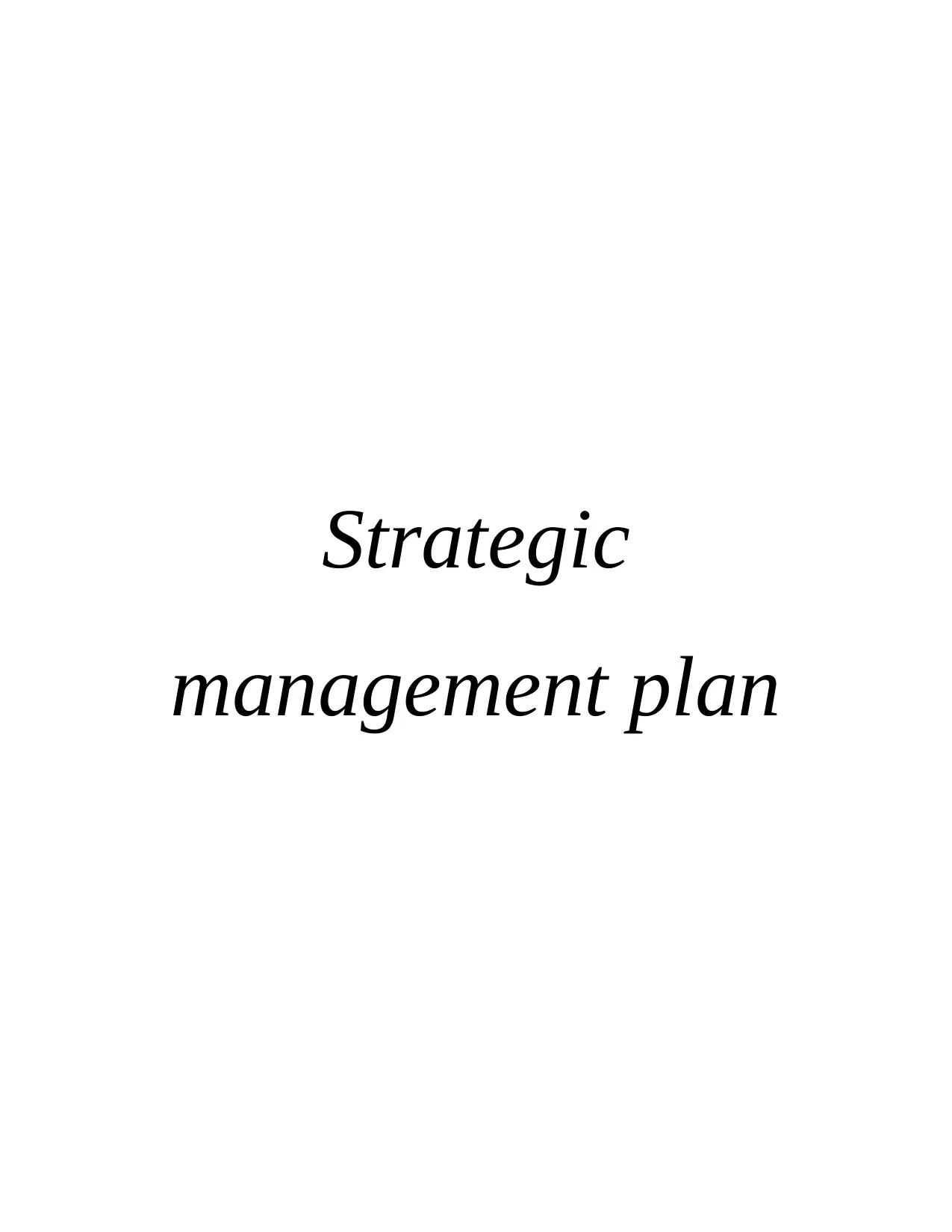
Strategic
management plan
management plan
Paraphrase This Document
Need a fresh take? Get an instant paraphrase of this document with our AI Paraphraser
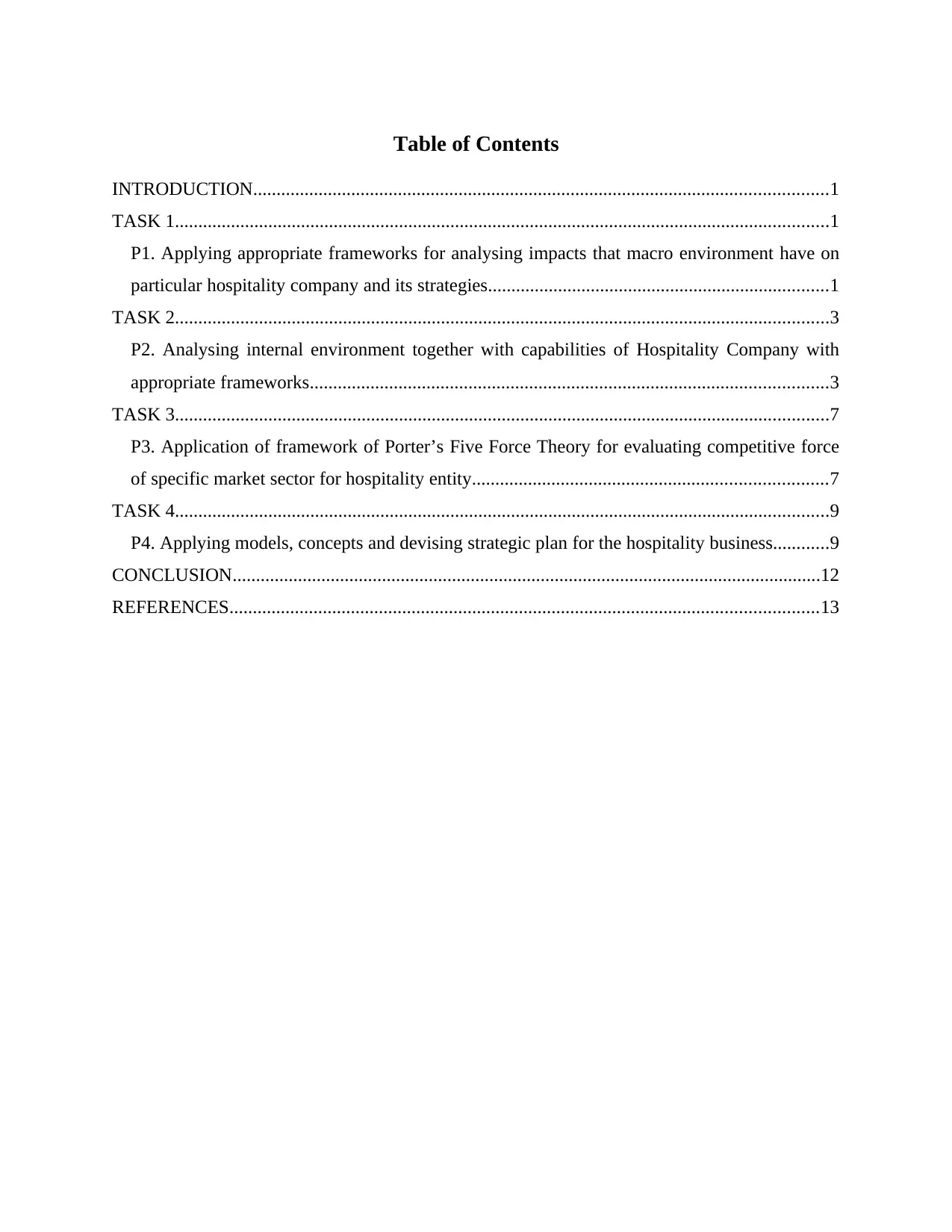
Table of Contents
INTRODUCTION...........................................................................................................................1
TASK 1............................................................................................................................................1
P1. Applying appropriate frameworks for analysing impacts that macro environment have on
particular hospitality company and its strategies.........................................................................1
TASK 2............................................................................................................................................3
P2. Analysing internal environment together with capabilities of Hospitality Company with
appropriate frameworks...............................................................................................................3
TASK 3............................................................................................................................................7
P3. Application of framework of Porter’s Five Force Theory for evaluating competitive force
of specific market sector for hospitality entity............................................................................7
TASK 4............................................................................................................................................9
P4. Applying models, concepts and devising strategic plan for the hospitality business............9
CONCLUSION..............................................................................................................................12
REFERENCES..............................................................................................................................13
INTRODUCTION...........................................................................................................................1
TASK 1............................................................................................................................................1
P1. Applying appropriate frameworks for analysing impacts that macro environment have on
particular hospitality company and its strategies.........................................................................1
TASK 2............................................................................................................................................3
P2. Analysing internal environment together with capabilities of Hospitality Company with
appropriate frameworks...............................................................................................................3
TASK 3............................................................................................................................................7
P3. Application of framework of Porter’s Five Force Theory for evaluating competitive force
of specific market sector for hospitality entity............................................................................7
TASK 4............................................................................................................................................9
P4. Applying models, concepts and devising strategic plan for the hospitality business............9
CONCLUSION..............................................................................................................................12
REFERENCES..............................................................................................................................13
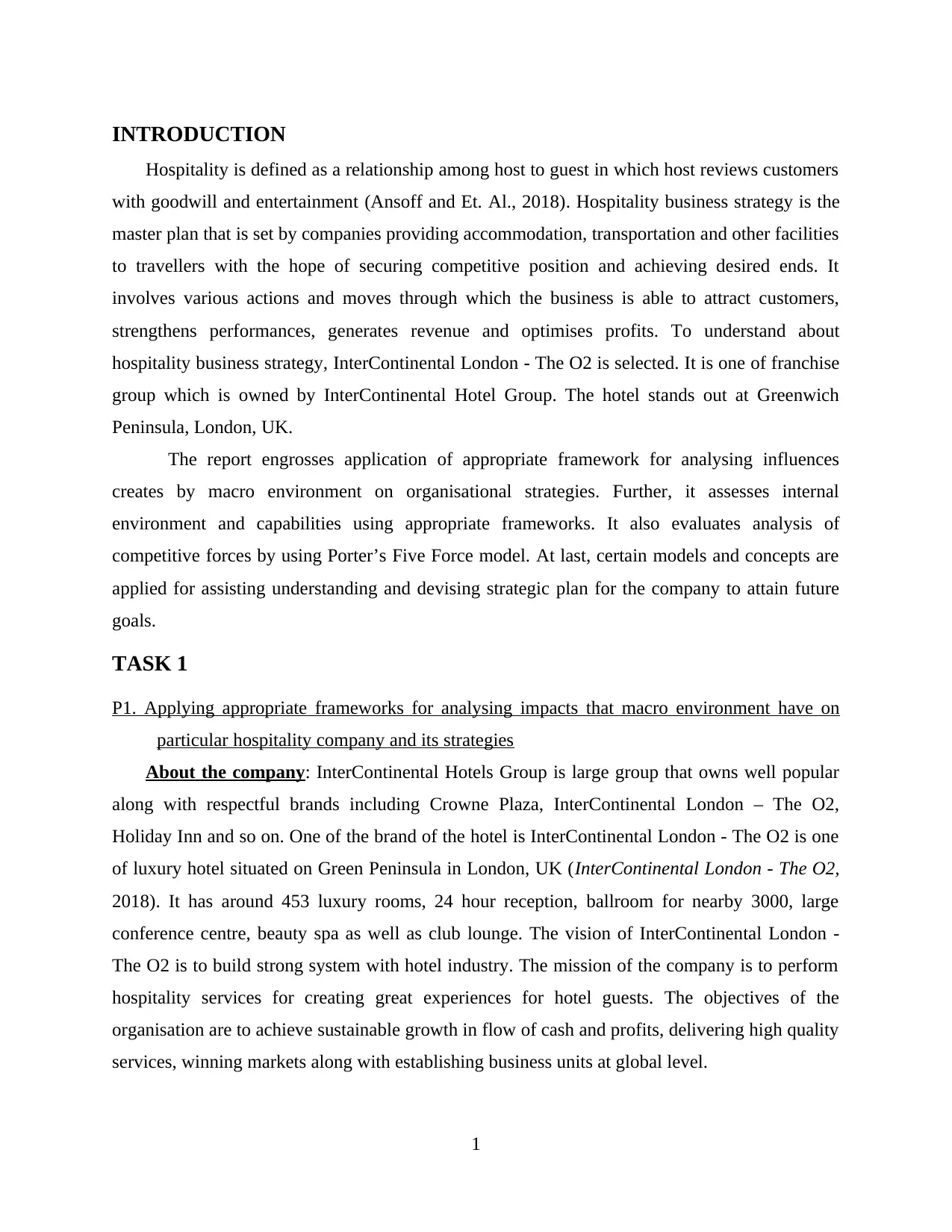
INTRODUCTION
Hospitality is defined as a relationship among host to guest in which host reviews customers
with goodwill and entertainment (Ansoff and Et. Al., 2018). Hospitality business strategy is the
master plan that is set by companies providing accommodation, transportation and other facilities
to travellers with the hope of securing competitive position and achieving desired ends. It
involves various actions and moves through which the business is able to attract customers,
strengthens performances, generates revenue and optimises profits. To understand about
hospitality business strategy, InterContinental London - The O2 is selected. It is one of franchise
group which is owned by InterContinental Hotel Group. The hotel stands out at Greenwich
Peninsula, London, UK.
The report engrosses application of appropriate framework for analysing influences
creates by macro environment on organisational strategies. Further, it assesses internal
environment and capabilities using appropriate frameworks. It also evaluates analysis of
competitive forces by using Porter’s Five Force model. At last, certain models and concepts are
applied for assisting understanding and devising strategic plan for the company to attain future
goals.
TASK 1
P1. Applying appropriate frameworks for analysing impacts that macro environment have on
particular hospitality company and its strategies
About the company: InterContinental Hotels Group is large group that owns well popular
along with respectful brands including Crowne Plaza, InterContinental London – The O2,
Holiday Inn and so on. One of the brand of the hotel is InterContinental London - The O2 is one
of luxury hotel situated on Green Peninsula in London, UK (InterContinental London - The O2,
2018). It has around 453 luxury rooms, 24 hour reception, ballroom for nearby 3000, large
conference centre, beauty spa as well as club lounge. The vision of InterContinental London -
The O2 is to build strong system with hotel industry. The mission of the company is to perform
hospitality services for creating great experiences for hotel guests. The objectives of the
organisation are to achieve sustainable growth in flow of cash and profits, delivering high quality
services, winning markets along with establishing business units at global level.
1
Hospitality is defined as a relationship among host to guest in which host reviews customers
with goodwill and entertainment (Ansoff and Et. Al., 2018). Hospitality business strategy is the
master plan that is set by companies providing accommodation, transportation and other facilities
to travellers with the hope of securing competitive position and achieving desired ends. It
involves various actions and moves through which the business is able to attract customers,
strengthens performances, generates revenue and optimises profits. To understand about
hospitality business strategy, InterContinental London - The O2 is selected. It is one of franchise
group which is owned by InterContinental Hotel Group. The hotel stands out at Greenwich
Peninsula, London, UK.
The report engrosses application of appropriate framework for analysing influences
creates by macro environment on organisational strategies. Further, it assesses internal
environment and capabilities using appropriate frameworks. It also evaluates analysis of
competitive forces by using Porter’s Five Force model. At last, certain models and concepts are
applied for assisting understanding and devising strategic plan for the company to attain future
goals.
TASK 1
P1. Applying appropriate frameworks for analysing impacts that macro environment have on
particular hospitality company and its strategies
About the company: InterContinental Hotels Group is large group that owns well popular
along with respectful brands including Crowne Plaza, InterContinental London – The O2,
Holiday Inn and so on. One of the brand of the hotel is InterContinental London - The O2 is one
of luxury hotel situated on Green Peninsula in London, UK (InterContinental London - The O2,
2018). It has around 453 luxury rooms, 24 hour reception, ballroom for nearby 3000, large
conference centre, beauty spa as well as club lounge. The vision of InterContinental London -
The O2 is to build strong system with hotel industry. The mission of the company is to perform
hospitality services for creating great experiences for hotel guests. The objectives of the
organisation are to achieve sustainable growth in flow of cash and profits, delivering high quality
services, winning markets along with establishing business units at global level.
1
⊘ This is a preview!⊘
Do you want full access?
Subscribe today to unlock all pages.

Trusted by 1+ million students worldwide
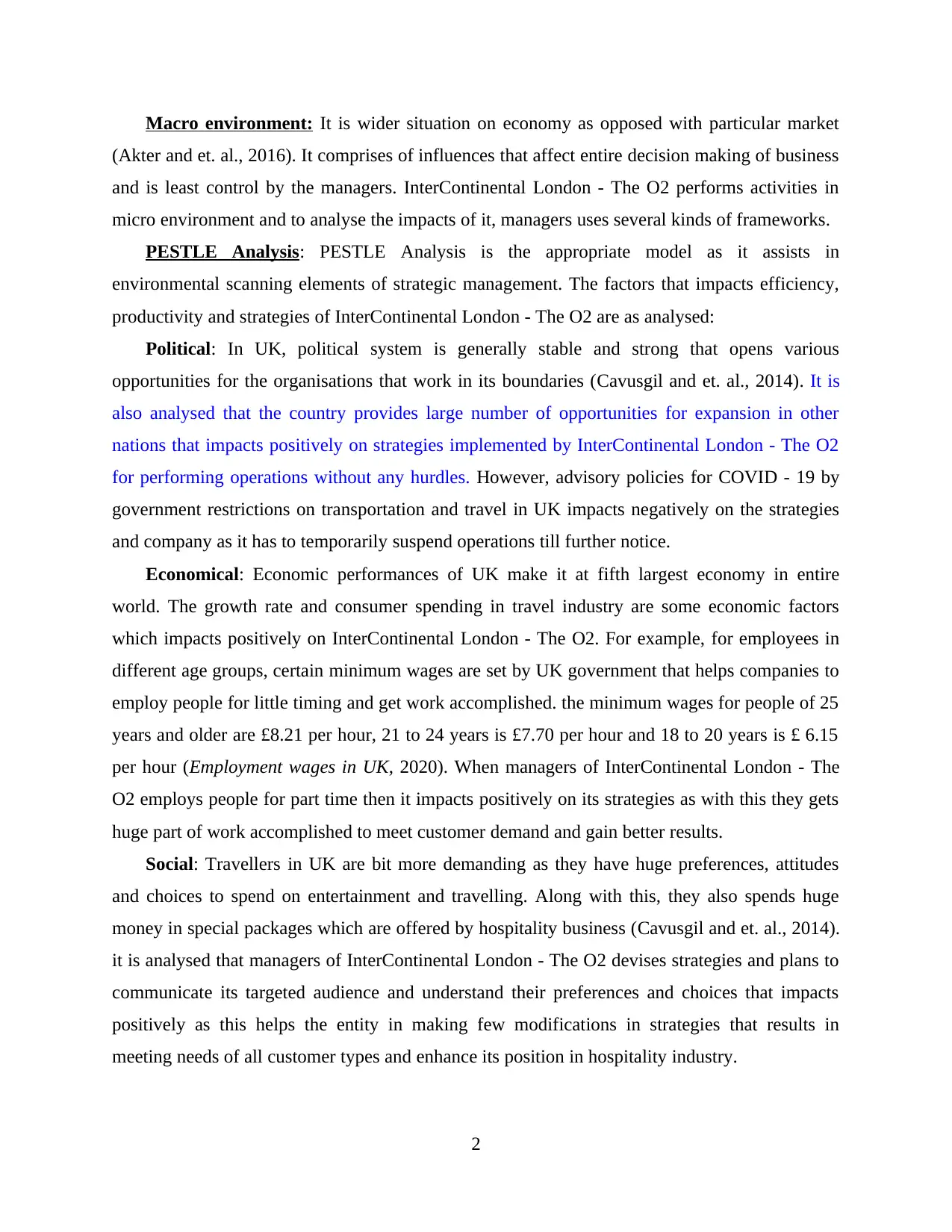
Macro environment: It is wider situation on economy as opposed with particular market
(Akter and et. al., 2016). It comprises of influences that affect entire decision making of business
and is least control by the managers. InterContinental London - The O2 performs activities in
micro environment and to analyse the impacts of it, managers uses several kinds of frameworks.
PESTLE Analysis: PESTLE Analysis is the appropriate model as it assists in
environmental scanning elements of strategic management. The factors that impacts efficiency,
productivity and strategies of InterContinental London - The O2 are as analysed:
Political: In UK, political system is generally stable and strong that opens various
opportunities for the organisations that work in its boundaries (Cavusgil and et. al., 2014). It is
also analysed that the country provides large number of opportunities for expansion in other
nations that impacts positively on strategies implemented by InterContinental London - The O2
for performing operations without any hurdles. However, advisory policies for COVID - 19 by
government restrictions on transportation and travel in UK impacts negatively on the strategies
and company as it has to temporarily suspend operations till further notice.
Economical: Economic performances of UK make it at fifth largest economy in entire
world. The growth rate and consumer spending in travel industry are some economic factors
which impacts positively on InterContinental London - The O2. For example, for employees in
different age groups, certain minimum wages are set by UK government that helps companies to
employ people for little timing and get work accomplished. the minimum wages for people of 25
years and older are £8.21 per hour, 21 to 24 years is £7.70 per hour and 18 to 20 years is £ 6.15
per hour (Employment wages in UK, 2020). When managers of InterContinental London - The
O2 employs people for part time then it impacts positively on its strategies as with this they gets
huge part of work accomplished to meet customer demand and gain better results.
Social: Travellers in UK are bit more demanding as they have huge preferences, attitudes
and choices to spend on entertainment and travelling. Along with this, they also spends huge
money in special packages which are offered by hospitality business (Cavusgil and et. al., 2014).
it is analysed that managers of InterContinental London - The O2 devises strategies and plans to
communicate its targeted audience and understand their preferences and choices that impacts
positively as this helps the entity in making few modifications in strategies that results in
meeting needs of all customer types and enhance its position in hospitality industry.
2
(Akter and et. al., 2016). It comprises of influences that affect entire decision making of business
and is least control by the managers. InterContinental London - The O2 performs activities in
micro environment and to analyse the impacts of it, managers uses several kinds of frameworks.
PESTLE Analysis: PESTLE Analysis is the appropriate model as it assists in
environmental scanning elements of strategic management. The factors that impacts efficiency,
productivity and strategies of InterContinental London - The O2 are as analysed:
Political: In UK, political system is generally stable and strong that opens various
opportunities for the organisations that work in its boundaries (Cavusgil and et. al., 2014). It is
also analysed that the country provides large number of opportunities for expansion in other
nations that impacts positively on strategies implemented by InterContinental London - The O2
for performing operations without any hurdles. However, advisory policies for COVID - 19 by
government restrictions on transportation and travel in UK impacts negatively on the strategies
and company as it has to temporarily suspend operations till further notice.
Economical: Economic performances of UK make it at fifth largest economy in entire
world. The growth rate and consumer spending in travel industry are some economic factors
which impacts positively on InterContinental London - The O2. For example, for employees in
different age groups, certain minimum wages are set by UK government that helps companies to
employ people for little timing and get work accomplished. the minimum wages for people of 25
years and older are £8.21 per hour, 21 to 24 years is £7.70 per hour and 18 to 20 years is £ 6.15
per hour (Employment wages in UK, 2020). When managers of InterContinental London - The
O2 employs people for part time then it impacts positively on its strategies as with this they gets
huge part of work accomplished to meet customer demand and gain better results.
Social: Travellers in UK are bit more demanding as they have huge preferences, attitudes
and choices to spend on entertainment and travelling. Along with this, they also spends huge
money in special packages which are offered by hospitality business (Cavusgil and et. al., 2014).
it is analysed that managers of InterContinental London - The O2 devises strategies and plans to
communicate its targeted audience and understand their preferences and choices that impacts
positively as this helps the entity in making few modifications in strategies that results in
meeting needs of all customer types and enhance its position in hospitality industry.
2
Paraphrase This Document
Need a fresh take? Get an instant paraphrase of this document with our AI Paraphraser
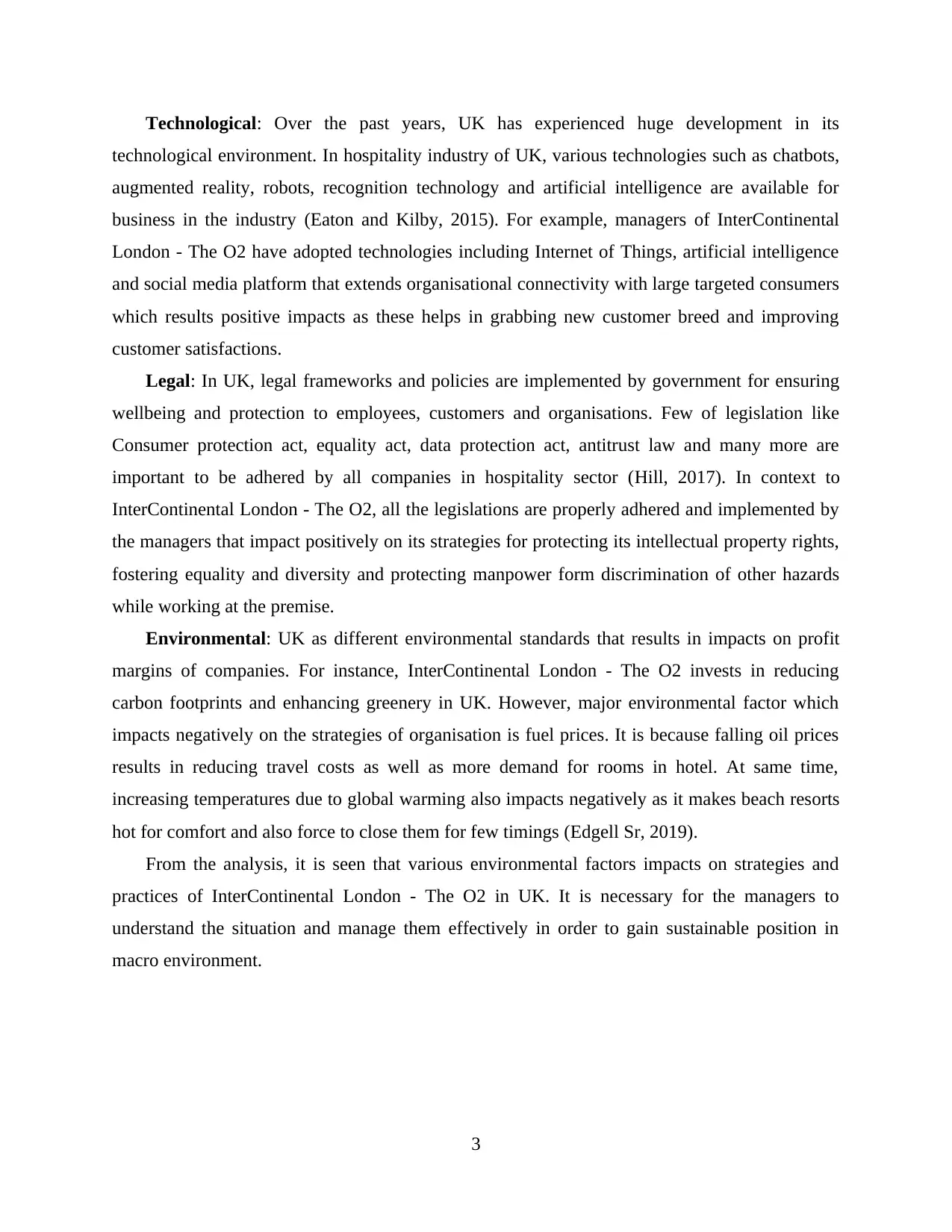
Technological: Over the past years, UK has experienced huge development in its
technological environment. In hospitality industry of UK, various technologies such as chatbots,
augmented reality, robots, recognition technology and artificial intelligence are available for
business in the industry (Eaton and Kilby, 2015). For example, managers of InterContinental
London - The O2 have adopted technologies including Internet of Things, artificial intelligence
and social media platform that extends organisational connectivity with large targeted consumers
which results positive impacts as these helps in grabbing new customer breed and improving
customer satisfactions.
Legal: In UK, legal frameworks and policies are implemented by government for ensuring
wellbeing and protection to employees, customers and organisations. Few of legislation like
Consumer protection act, equality act, data protection act, antitrust law and many more are
important to be adhered by all companies in hospitality sector (Hill, 2017). In context to
InterContinental London - The O2, all the legislations are properly adhered and implemented by
the managers that impact positively on its strategies for protecting its intellectual property rights,
fostering equality and diversity and protecting manpower form discrimination of other hazards
while working at the premise.
Environmental: UK as different environmental standards that results in impacts on profit
margins of companies. For instance, InterContinental London - The O2 invests in reducing
carbon footprints and enhancing greenery in UK. However, major environmental factor which
impacts negatively on the strategies of organisation is fuel prices. It is because falling oil prices
results in reducing travel costs as well as more demand for rooms in hotel. At same time,
increasing temperatures due to global warming also impacts negatively as it makes beach resorts
hot for comfort and also force to close them for few timings (Edgell Sr, 2019).
From the analysis, it is seen that various environmental factors impacts on strategies and
practices of InterContinental London - The O2 in UK. It is necessary for the managers to
understand the situation and manage them effectively in order to gain sustainable position in
macro environment.
3
technological environment. In hospitality industry of UK, various technologies such as chatbots,
augmented reality, robots, recognition technology and artificial intelligence are available for
business in the industry (Eaton and Kilby, 2015). For example, managers of InterContinental
London - The O2 have adopted technologies including Internet of Things, artificial intelligence
and social media platform that extends organisational connectivity with large targeted consumers
which results positive impacts as these helps in grabbing new customer breed and improving
customer satisfactions.
Legal: In UK, legal frameworks and policies are implemented by government for ensuring
wellbeing and protection to employees, customers and organisations. Few of legislation like
Consumer protection act, equality act, data protection act, antitrust law and many more are
important to be adhered by all companies in hospitality sector (Hill, 2017). In context to
InterContinental London - The O2, all the legislations are properly adhered and implemented by
the managers that impact positively on its strategies for protecting its intellectual property rights,
fostering equality and diversity and protecting manpower form discrimination of other hazards
while working at the premise.
Environmental: UK as different environmental standards that results in impacts on profit
margins of companies. For instance, InterContinental London - The O2 invests in reducing
carbon footprints and enhancing greenery in UK. However, major environmental factor which
impacts negatively on the strategies of organisation is fuel prices. It is because falling oil prices
results in reducing travel costs as well as more demand for rooms in hotel. At same time,
increasing temperatures due to global warming also impacts negatively as it makes beach resorts
hot for comfort and also force to close them for few timings (Edgell Sr, 2019).
From the analysis, it is seen that various environmental factors impacts on strategies and
practices of InterContinental London - The O2 in UK. It is necessary for the managers to
understand the situation and manage them effectively in order to gain sustainable position in
macro environment.
3
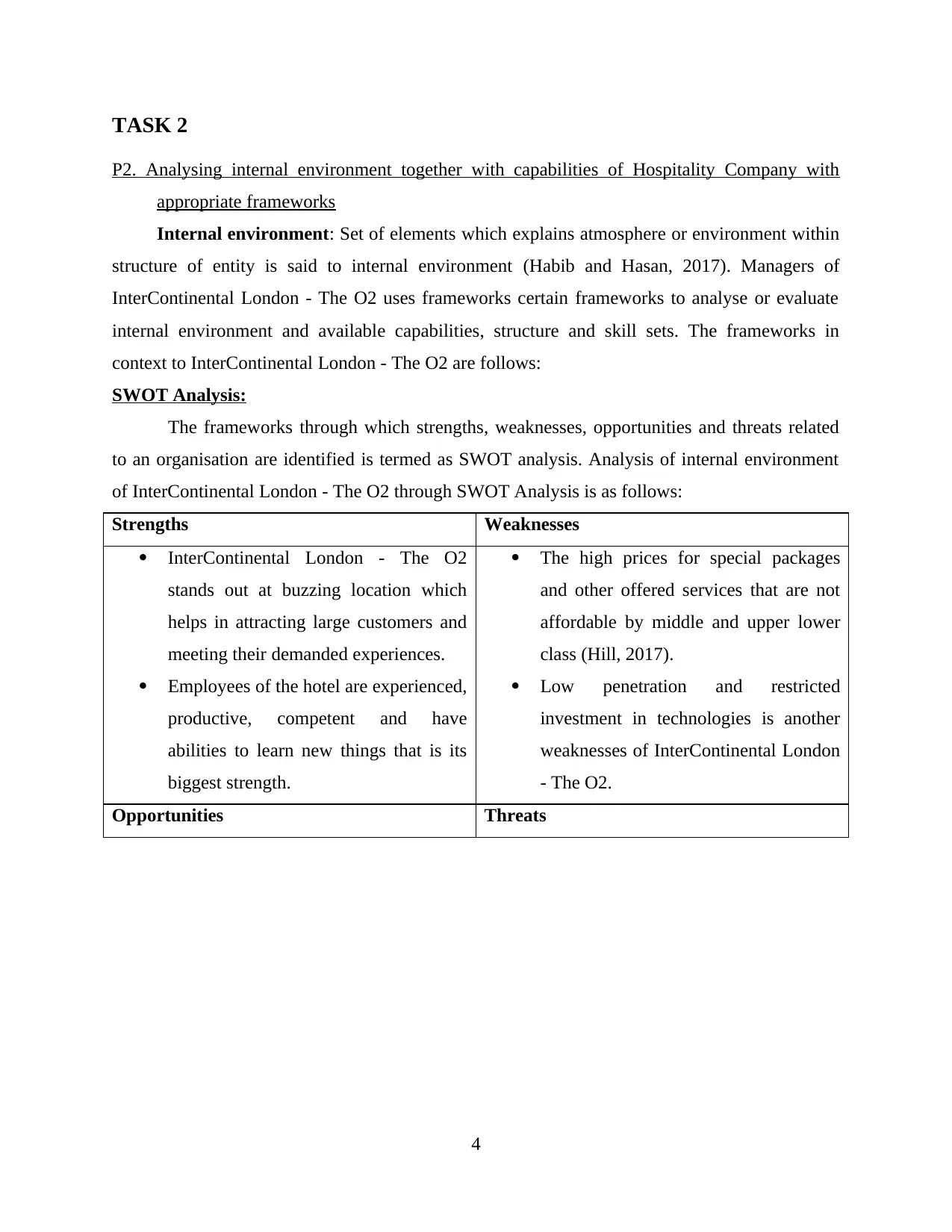
TASK 2
P2. Analysing internal environment together with capabilities of Hospitality Company with
appropriate frameworks
Internal environment: Set of elements which explains atmosphere or environment within
structure of entity is said to internal environment (Habib and Hasan, 2017). Managers of
InterContinental London - The O2 uses frameworks certain frameworks to analyse or evaluate
internal environment and available capabilities, structure and skill sets. The frameworks in
context to InterContinental London - The O2 are follows:
SWOT Analysis:
The frameworks through which strengths, weaknesses, opportunities and threats related
to an organisation are identified is termed as SWOT analysis. Analysis of internal environment
of InterContinental London - The O2 through SWOT Analysis is as follows:
Strengths Weaknesses
InterContinental London - The O2
stands out at buzzing location which
helps in attracting large customers and
meeting their demanded experiences.
Employees of the hotel are experienced,
productive, competent and have
abilities to learn new things that is its
biggest strength.
The high prices for special packages
and other offered services that are not
affordable by middle and upper lower
class (Hill, 2017).
Low penetration and restricted
investment in technologies is another
weaknesses of InterContinental London
- The O2.
Opportunities Threats
4
P2. Analysing internal environment together with capabilities of Hospitality Company with
appropriate frameworks
Internal environment: Set of elements which explains atmosphere or environment within
structure of entity is said to internal environment (Habib and Hasan, 2017). Managers of
InterContinental London - The O2 uses frameworks certain frameworks to analyse or evaluate
internal environment and available capabilities, structure and skill sets. The frameworks in
context to InterContinental London - The O2 are follows:
SWOT Analysis:
The frameworks through which strengths, weaknesses, opportunities and threats related
to an organisation are identified is termed as SWOT analysis. Analysis of internal environment
of InterContinental London - The O2 through SWOT Analysis is as follows:
Strengths Weaknesses
InterContinental London - The O2
stands out at buzzing location which
helps in attracting large customers and
meeting their demanded experiences.
Employees of the hotel are experienced,
productive, competent and have
abilities to learn new things that is its
biggest strength.
The high prices for special packages
and other offered services that are not
affordable by middle and upper lower
class (Hill, 2017).
Low penetration and restricted
investment in technologies is another
weaknesses of InterContinental London
- The O2.
Opportunities Threats
4
⊘ This is a preview!⊘
Do you want full access?
Subscribe today to unlock all pages.

Trusted by 1+ million students worldwide
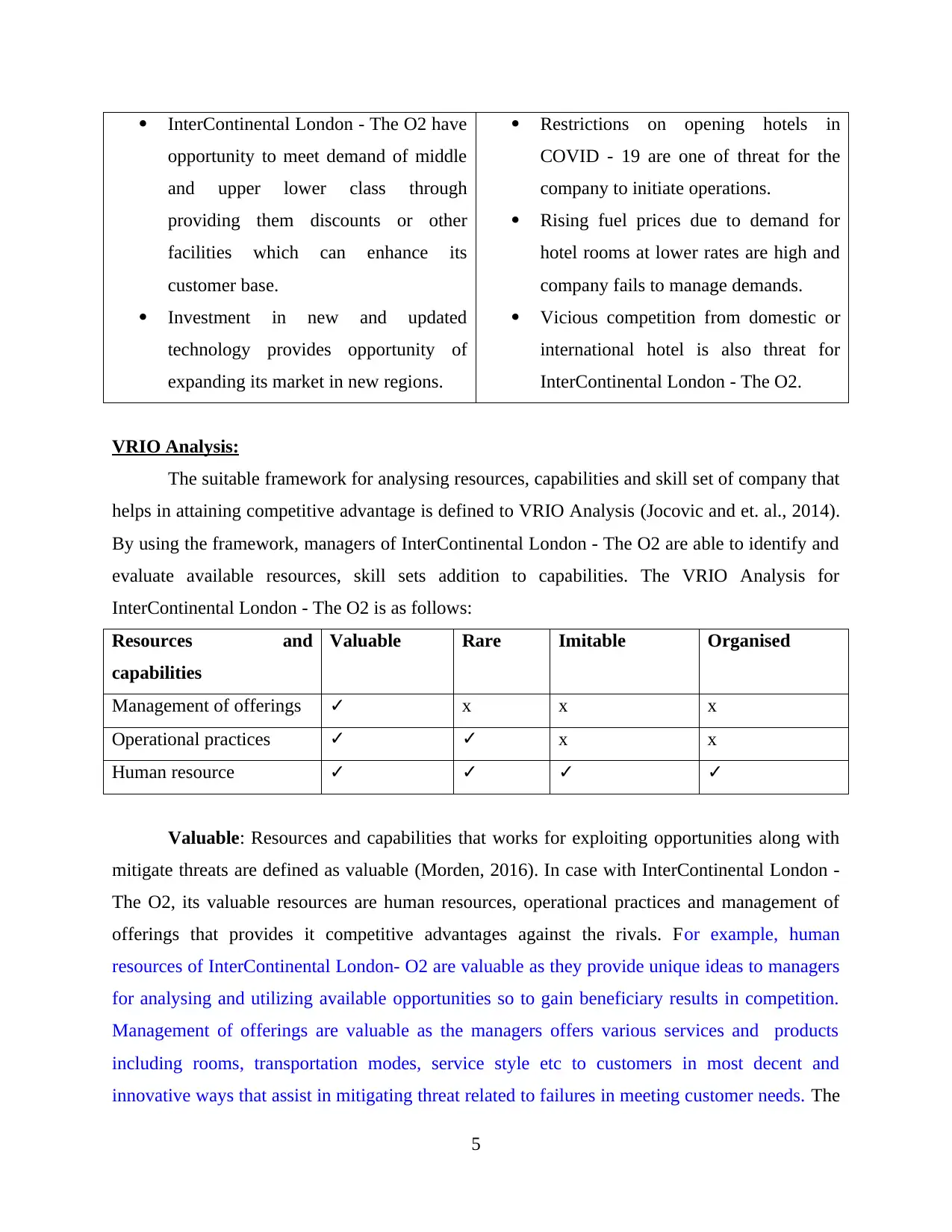
InterContinental London - The O2 have
opportunity to meet demand of middle
and upper lower class through
providing them discounts or other
facilities which can enhance its
customer base.
Investment in new and updated
technology provides opportunity of
expanding its market in new regions.
Restrictions on opening hotels in
COVID - 19 are one of threat for the
company to initiate operations.
Rising fuel prices due to demand for
hotel rooms at lower rates are high and
company fails to manage demands.
Vicious competition from domestic or
international hotel is also threat for
InterContinental London - The O2.
VRIO Analysis:
The suitable framework for analysing resources, capabilities and skill set of company that
helps in attaining competitive advantage is defined to VRIO Analysis (Jocovic and et. al., 2014).
By using the framework, managers of InterContinental London - The O2 are able to identify and
evaluate available resources, skill sets addition to capabilities. The VRIO Analysis for
InterContinental London - The O2 is as follows:
Resources and
capabilities
Valuable Rare Imitable Organised
Management of offerings ✓ x x x
Operational practices ✓ ✓ x x
Human resource ✓ ✓ ✓ ✓
Valuable: Resources and capabilities that works for exploiting opportunities along with
mitigate threats are defined as valuable (Morden, 2016). In case with InterContinental London -
The O2, its valuable resources are human resources, operational practices and management of
offerings that provides it competitive advantages against the rivals. For example, human
resources of InterContinental London- O2 are valuable as they provide unique ideas to managers
for analysing and utilizing available opportunities so to gain beneficiary results in competition.
Management of offerings are valuable as the managers offers various services and products
including rooms, transportation modes, service style etc to customers in most decent and
innovative ways that assist in mitigating threat related to failures in meeting customer needs. The
5
opportunity to meet demand of middle
and upper lower class through
providing them discounts or other
facilities which can enhance its
customer base.
Investment in new and updated
technology provides opportunity of
expanding its market in new regions.
Restrictions on opening hotels in
COVID - 19 are one of threat for the
company to initiate operations.
Rising fuel prices due to demand for
hotel rooms at lower rates are high and
company fails to manage demands.
Vicious competition from domestic or
international hotel is also threat for
InterContinental London - The O2.
VRIO Analysis:
The suitable framework for analysing resources, capabilities and skill set of company that
helps in attaining competitive advantage is defined to VRIO Analysis (Jocovic and et. al., 2014).
By using the framework, managers of InterContinental London - The O2 are able to identify and
evaluate available resources, skill sets addition to capabilities. The VRIO Analysis for
InterContinental London - The O2 is as follows:
Resources and
capabilities
Valuable Rare Imitable Organised
Management of offerings ✓ x x x
Operational practices ✓ ✓ x x
Human resource ✓ ✓ ✓ ✓
Valuable: Resources and capabilities that works for exploiting opportunities along with
mitigate threats are defined as valuable (Morden, 2016). In case with InterContinental London -
The O2, its valuable resources are human resources, operational practices and management of
offerings that provides it competitive advantages against the rivals. For example, human
resources of InterContinental London- O2 are valuable as they provide unique ideas to managers
for analysing and utilizing available opportunities so to gain beneficiary results in competition.
Management of offerings are valuable as the managers offers various services and products
including rooms, transportation modes, service style etc to customers in most decent and
innovative ways that assist in mitigating threat related to failures in meeting customer needs. The
5
Paraphrase This Document
Need a fresh take? Get an instant paraphrase of this document with our AI Paraphraser
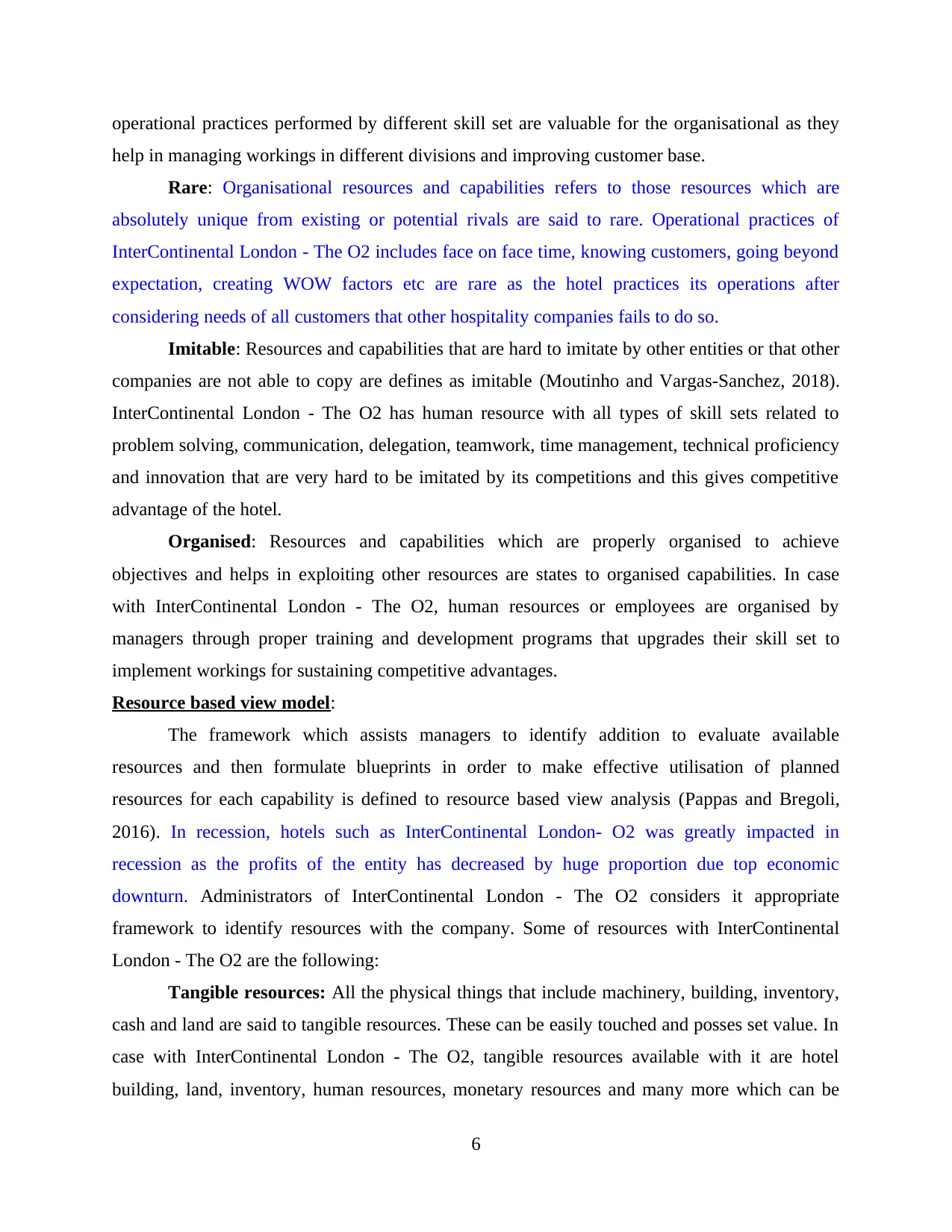
operational practices performed by different skill set are valuable for the organisational as they
help in managing workings in different divisions and improving customer base.
Rare: Organisational resources and capabilities refers to those resources which are
absolutely unique from existing or potential rivals are said to rare. Operational practices of
InterContinental London - The O2 includes face on face time, knowing customers, going beyond
expectation, creating WOW factors etc are rare as the hotel practices its operations after
considering needs of all customers that other hospitality companies fails to do so.
Imitable: Resources and capabilities that are hard to imitate by other entities or that other
companies are not able to copy are defines as imitable (Moutinho and Vargas-Sanchez, 2018).
InterContinental London - The O2 has human resource with all types of skill sets related to
problem solving, communication, delegation, teamwork, time management, technical proficiency
and innovation that are very hard to be imitated by its competitions and this gives competitive
advantage of the hotel.
Organised: Resources and capabilities which are properly organised to achieve
objectives and helps in exploiting other resources are states to organised capabilities. In case
with InterContinental London - The O2, human resources or employees are organised by
managers through proper training and development programs that upgrades their skill set to
implement workings for sustaining competitive advantages.
Resource based view model:
The framework which assists managers to identify addition to evaluate available
resources and then formulate blueprints in order to make effective utilisation of planned
resources for each capability is defined to resource based view analysis (Pappas and Bregoli,
2016). In recession, hotels such as InterContinental London- O2 was greatly impacted in
recession as the profits of the entity has decreased by huge proportion due top economic
downturn. Administrators of InterContinental London - The O2 considers it appropriate
framework to identify resources with the company. Some of resources with InterContinental
London - The O2 are the following:
Tangible resources: All the physical things that include machinery, building, inventory,
cash and land are said to tangible resources. These can be easily touched and posses set value. In
case with InterContinental London - The O2, tangible resources available with it are hotel
building, land, inventory, human resources, monetary resources and many more which can be
6
help in managing workings in different divisions and improving customer base.
Rare: Organisational resources and capabilities refers to those resources which are
absolutely unique from existing or potential rivals are said to rare. Operational practices of
InterContinental London - The O2 includes face on face time, knowing customers, going beyond
expectation, creating WOW factors etc are rare as the hotel practices its operations after
considering needs of all customers that other hospitality companies fails to do so.
Imitable: Resources and capabilities that are hard to imitate by other entities or that other
companies are not able to copy are defines as imitable (Moutinho and Vargas-Sanchez, 2018).
InterContinental London - The O2 has human resource with all types of skill sets related to
problem solving, communication, delegation, teamwork, time management, technical proficiency
and innovation that are very hard to be imitated by its competitions and this gives competitive
advantage of the hotel.
Organised: Resources and capabilities which are properly organised to achieve
objectives and helps in exploiting other resources are states to organised capabilities. In case
with InterContinental London - The O2, human resources or employees are organised by
managers through proper training and development programs that upgrades their skill set to
implement workings for sustaining competitive advantages.
Resource based view model:
The framework which assists managers to identify addition to evaluate available
resources and then formulate blueprints in order to make effective utilisation of planned
resources for each capability is defined to resource based view analysis (Pappas and Bregoli,
2016). In recession, hotels such as InterContinental London- O2 was greatly impacted in
recession as the profits of the entity has decreased by huge proportion due top economic
downturn. Administrators of InterContinental London - The O2 considers it appropriate
framework to identify resources with the company. Some of resources with InterContinental
London - The O2 are the following:
Tangible resources: All the physical things that include machinery, building, inventory,
cash and land are said to tangible resources. These can be easily touched and posses set value. In
case with InterContinental London - The O2, tangible resources available with it are hotel
building, land, inventory, human resources, monetary resources and many more which can be
6
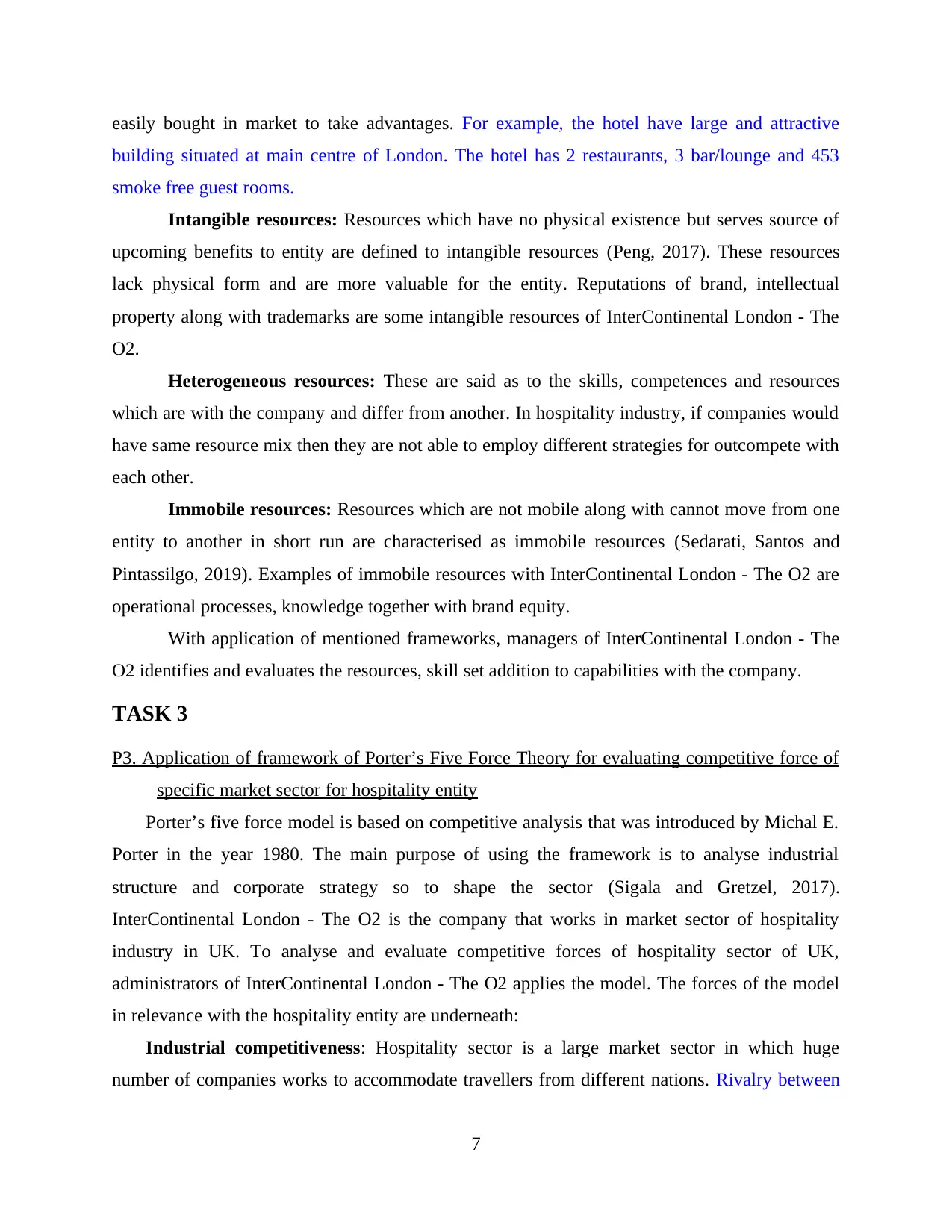
easily bought in market to take advantages. For example, the hotel have large and attractive
building situated at main centre of London. The hotel has 2 restaurants, 3 bar/lounge and 453
smoke free guest rooms.
Intangible resources: Resources which have no physical existence but serves source of
upcoming benefits to entity are defined to intangible resources (Peng, 2017). These resources
lack physical form and are more valuable for the entity. Reputations of brand, intellectual
property along with trademarks are some intangible resources of InterContinental London - The
O2.
Heterogeneous resources: These are said as to the skills, competences and resources
which are with the company and differ from another. In hospitality industry, if companies would
have same resource mix then they are not able to employ different strategies for outcompete with
each other.
Immobile resources: Resources which are not mobile along with cannot move from one
entity to another in short run are characterised as immobile resources (Sedarati, Santos and
Pintassilgo, 2019). Examples of immobile resources with InterContinental London - The O2 are
operational processes, knowledge together with brand equity.
With application of mentioned frameworks, managers of InterContinental London - The
O2 identifies and evaluates the resources, skill set addition to capabilities with the company.
TASK 3
P3. Application of framework of Porter’s Five Force Theory for evaluating competitive force of
specific market sector for hospitality entity
Porter’s five force model is based on competitive analysis that was introduced by Michal E.
Porter in the year 1980. The main purpose of using the framework is to analyse industrial
structure and corporate strategy so to shape the sector (Sigala and Gretzel, 2017).
InterContinental London - The O2 is the company that works in market sector of hospitality
industry in UK. To analyse and evaluate competitive forces of hospitality sector of UK,
administrators of InterContinental London - The O2 applies the model. The forces of the model
in relevance with the hospitality entity are underneath:
Industrial competitiveness: Hospitality sector is a large market sector in which huge
number of companies works to accommodate travellers from different nations. Rivalry between
7
building situated at main centre of London. The hotel has 2 restaurants, 3 bar/lounge and 453
smoke free guest rooms.
Intangible resources: Resources which have no physical existence but serves source of
upcoming benefits to entity are defined to intangible resources (Peng, 2017). These resources
lack physical form and are more valuable for the entity. Reputations of brand, intellectual
property along with trademarks are some intangible resources of InterContinental London - The
O2.
Heterogeneous resources: These are said as to the skills, competences and resources
which are with the company and differ from another. In hospitality industry, if companies would
have same resource mix then they are not able to employ different strategies for outcompete with
each other.
Immobile resources: Resources which are not mobile along with cannot move from one
entity to another in short run are characterised as immobile resources (Sedarati, Santos and
Pintassilgo, 2019). Examples of immobile resources with InterContinental London - The O2 are
operational processes, knowledge together with brand equity.
With application of mentioned frameworks, managers of InterContinental London - The
O2 identifies and evaluates the resources, skill set addition to capabilities with the company.
TASK 3
P3. Application of framework of Porter’s Five Force Theory for evaluating competitive force of
specific market sector for hospitality entity
Porter’s five force model is based on competitive analysis that was introduced by Michal E.
Porter in the year 1980. The main purpose of using the framework is to analyse industrial
structure and corporate strategy so to shape the sector (Sigala and Gretzel, 2017).
InterContinental London - The O2 is the company that works in market sector of hospitality
industry in UK. To analyse and evaluate competitive forces of hospitality sector of UK,
administrators of InterContinental London - The O2 applies the model. The forces of the model
in relevance with the hospitality entity are underneath:
Industrial competitiveness: Hospitality sector is a large market sector in which huge
number of companies works to accommodate travellers from different nations. Rivalry between
7
⊘ This is a preview!⊘
Do you want full access?
Subscribe today to unlock all pages.

Trusted by 1+ million students worldwide
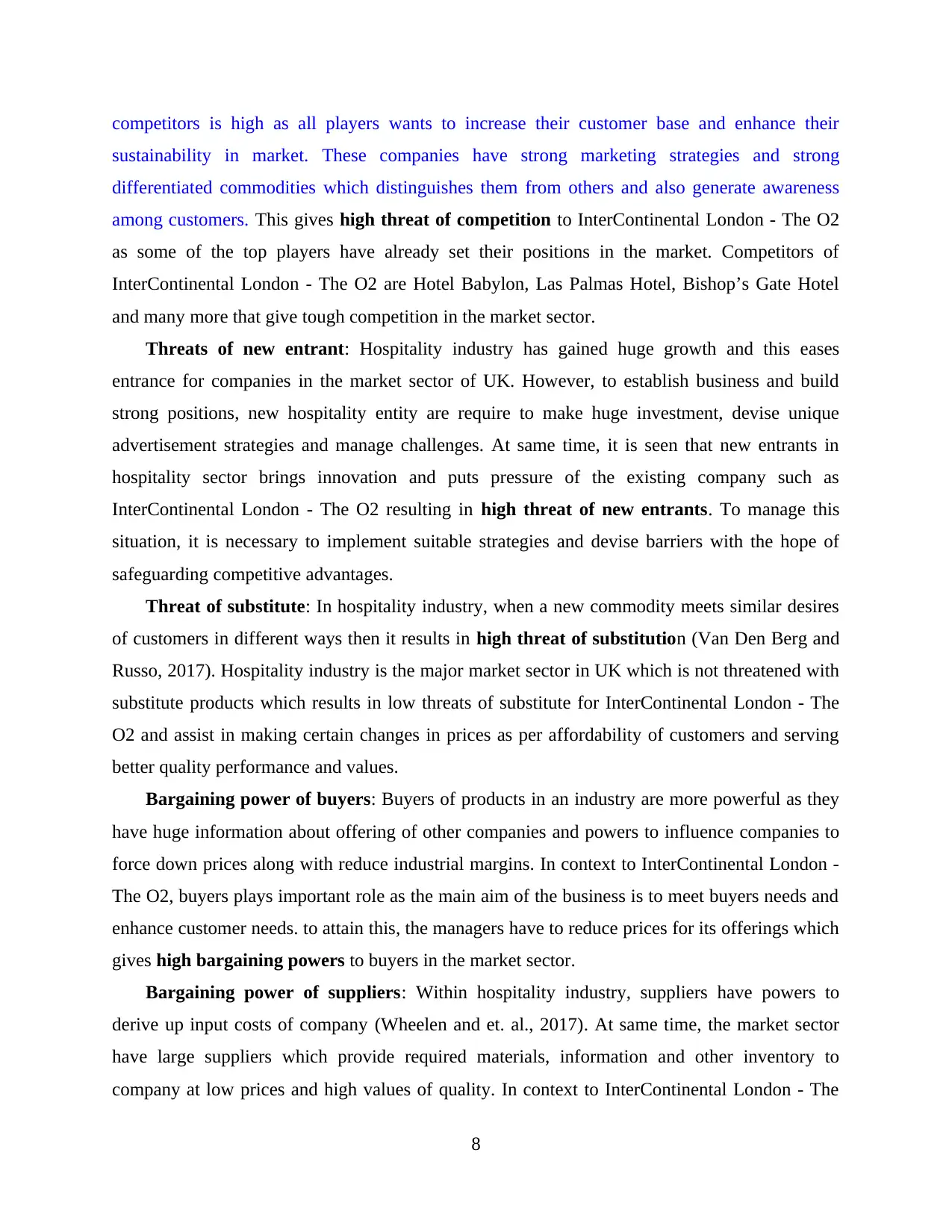
competitors is high as all players wants to increase their customer base and enhance their
sustainability in market. These companies have strong marketing strategies and strong
differentiated commodities which distinguishes them from others and also generate awareness
among customers. This gives high threat of competition to InterContinental London - The O2
as some of the top players have already set their positions in the market. Competitors of
InterContinental London - The O2 are Hotel Babylon, Las Palmas Hotel, Bishop’s Gate Hotel
and many more that give tough competition in the market sector.
Threats of new entrant: Hospitality industry has gained huge growth and this eases
entrance for companies in the market sector of UK. However, to establish business and build
strong positions, new hospitality entity are require to make huge investment, devise unique
advertisement strategies and manage challenges. At same time, it is seen that new entrants in
hospitality sector brings innovation and puts pressure of the existing company such as
InterContinental London - The O2 resulting in high threat of new entrants. To manage this
situation, it is necessary to implement suitable strategies and devise barriers with the hope of
safeguarding competitive advantages.
Threat of substitute: In hospitality industry, when a new commodity meets similar desires
of customers in different ways then it results in high threat of substitution (Van Den Berg and
Russo, 2017). Hospitality industry is the major market sector in UK which is not threatened with
substitute products which results in low threats of substitute for InterContinental London - The
O2 and assist in making certain changes in prices as per affordability of customers and serving
better quality performance and values.
Bargaining power of buyers: Buyers of products in an industry are more powerful as they
have huge information about offering of other companies and powers to influence companies to
force down prices along with reduce industrial margins. In context to InterContinental London -
The O2, buyers plays important role as the main aim of the business is to meet buyers needs and
enhance customer needs. to attain this, the managers have to reduce prices for its offerings which
gives high bargaining powers to buyers in the market sector.
Bargaining power of suppliers: Within hospitality industry, suppliers have powers to
derive up input costs of company (Wheelen and et. al., 2017). At same time, the market sector
have large suppliers which provide required materials, information and other inventory to
company at low prices and high values of quality. In context to InterContinental London - The
8
sustainability in market. These companies have strong marketing strategies and strong
differentiated commodities which distinguishes them from others and also generate awareness
among customers. This gives high threat of competition to InterContinental London - The O2
as some of the top players have already set their positions in the market. Competitors of
InterContinental London - The O2 are Hotel Babylon, Las Palmas Hotel, Bishop’s Gate Hotel
and many more that give tough competition in the market sector.
Threats of new entrant: Hospitality industry has gained huge growth and this eases
entrance for companies in the market sector of UK. However, to establish business and build
strong positions, new hospitality entity are require to make huge investment, devise unique
advertisement strategies and manage challenges. At same time, it is seen that new entrants in
hospitality sector brings innovation and puts pressure of the existing company such as
InterContinental London - The O2 resulting in high threat of new entrants. To manage this
situation, it is necessary to implement suitable strategies and devise barriers with the hope of
safeguarding competitive advantages.
Threat of substitute: In hospitality industry, when a new commodity meets similar desires
of customers in different ways then it results in high threat of substitution (Van Den Berg and
Russo, 2017). Hospitality industry is the major market sector in UK which is not threatened with
substitute products which results in low threats of substitute for InterContinental London - The
O2 and assist in making certain changes in prices as per affordability of customers and serving
better quality performance and values.
Bargaining power of buyers: Buyers of products in an industry are more powerful as they
have huge information about offering of other companies and powers to influence companies to
force down prices along with reduce industrial margins. In context to InterContinental London -
The O2, buyers plays important role as the main aim of the business is to meet buyers needs and
enhance customer needs. to attain this, the managers have to reduce prices for its offerings which
gives high bargaining powers to buyers in the market sector.
Bargaining power of suppliers: Within hospitality industry, suppliers have powers to
derive up input costs of company (Wheelen and et. al., 2017). At same time, the market sector
have large suppliers which provide required materials, information and other inventory to
company at low prices and high values of quality. In context to InterContinental London - The
8
Paraphrase This Document
Need a fresh take? Get an instant paraphrase of this document with our AI Paraphraser
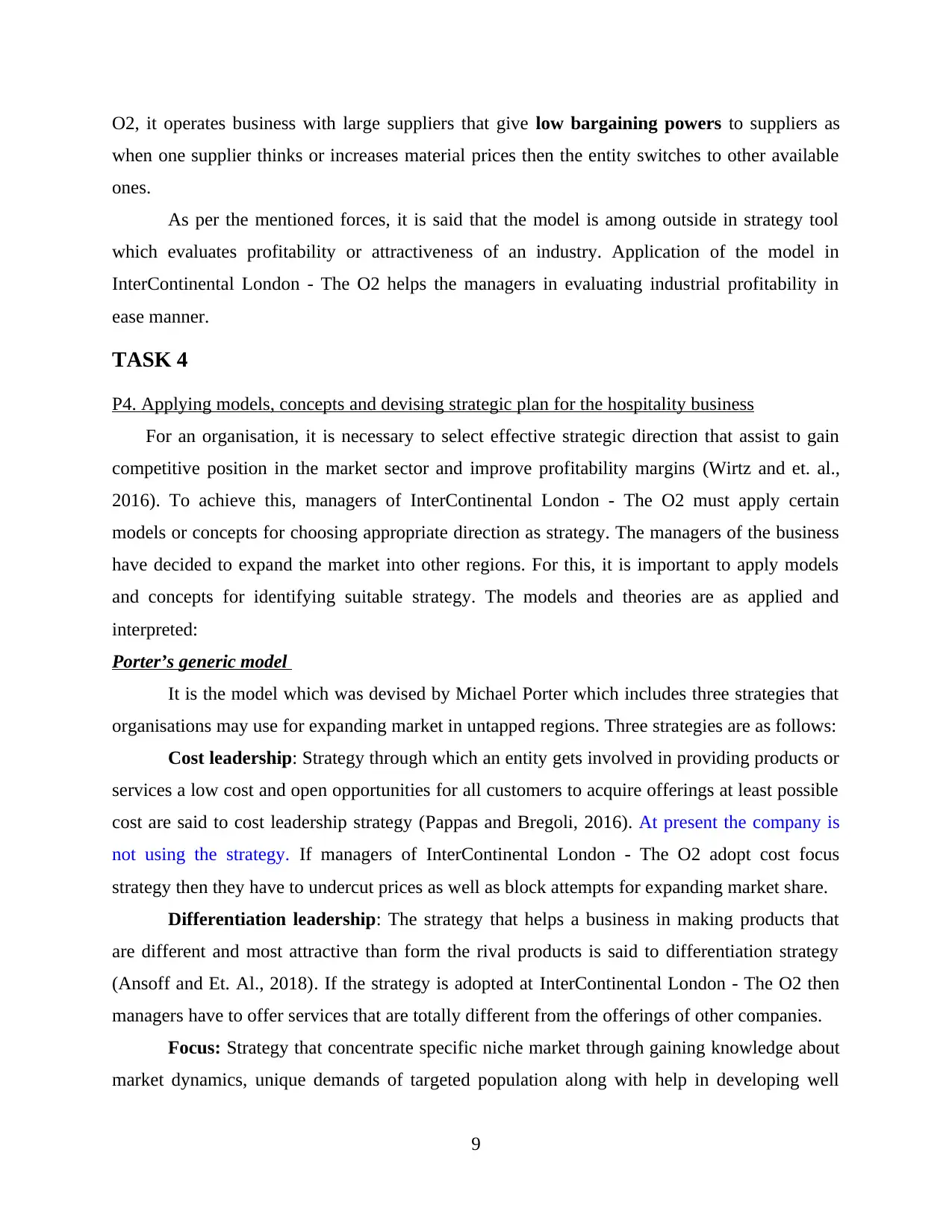
O2, it operates business with large suppliers that give low bargaining powers to suppliers as
when one supplier thinks or increases material prices then the entity switches to other available
ones.
As per the mentioned forces, it is said that the model is among outside in strategy tool
which evaluates profitability or attractiveness of an industry. Application of the model in
InterContinental London - The O2 helps the managers in evaluating industrial profitability in
ease manner.
TASK 4
P4. Applying models, concepts and devising strategic plan for the hospitality business
For an organisation, it is necessary to select effective strategic direction that assist to gain
competitive position in the market sector and improve profitability margins (Wirtz and et. al.,
2016). To achieve this, managers of InterContinental London - The O2 must apply certain
models or concepts for choosing appropriate direction as strategy. The managers of the business
have decided to expand the market into other regions. For this, it is important to apply models
and concepts for identifying suitable strategy. The models and theories are as applied and
interpreted:
Porter’s generic model
It is the model which was devised by Michael Porter which includes three strategies that
organisations may use for expanding market in untapped regions. Three strategies are as follows:
Cost leadership: Strategy through which an entity gets involved in providing products or
services a low cost and open opportunities for all customers to acquire offerings at least possible
cost are said to cost leadership strategy (Pappas and Bregoli, 2016). At present the company is
not using the strategy. If managers of InterContinental London - The O2 adopt cost focus
strategy then they have to undercut prices as well as block attempts for expanding market share.
Differentiation leadership: The strategy that helps a business in making products that
are different and most attractive than form the rival products is said to differentiation strategy
(Ansoff and Et. Al., 2018). If the strategy is adopted at InterContinental London - The O2 then
managers have to offer services that are totally different from the offerings of other companies.
Focus: Strategy that concentrate specific niche market through gaining knowledge about
market dynamics, unique demands of targeted population along with help in developing well
9
when one supplier thinks or increases material prices then the entity switches to other available
ones.
As per the mentioned forces, it is said that the model is among outside in strategy tool
which evaluates profitability or attractiveness of an industry. Application of the model in
InterContinental London - The O2 helps the managers in evaluating industrial profitability in
ease manner.
TASK 4
P4. Applying models, concepts and devising strategic plan for the hospitality business
For an organisation, it is necessary to select effective strategic direction that assist to gain
competitive position in the market sector and improve profitability margins (Wirtz and et. al.,
2016). To achieve this, managers of InterContinental London - The O2 must apply certain
models or concepts for choosing appropriate direction as strategy. The managers of the business
have decided to expand the market into other regions. For this, it is important to apply models
and concepts for identifying suitable strategy. The models and theories are as applied and
interpreted:
Porter’s generic model
It is the model which was devised by Michael Porter which includes three strategies that
organisations may use for expanding market in untapped regions. Three strategies are as follows:
Cost leadership: Strategy through which an entity gets involved in providing products or
services a low cost and open opportunities for all customers to acquire offerings at least possible
cost are said to cost leadership strategy (Pappas and Bregoli, 2016). At present the company is
not using the strategy. If managers of InterContinental London - The O2 adopt cost focus
strategy then they have to undercut prices as well as block attempts for expanding market share.
Differentiation leadership: The strategy that helps a business in making products that
are different and most attractive than form the rival products is said to differentiation strategy
(Ansoff and Et. Al., 2018). If the strategy is adopted at InterContinental London - The O2 then
managers have to offer services that are totally different from the offerings of other companies.
Focus: Strategy that concentrate specific niche market through gaining knowledge about
market dynamics, unique demands of targeted population along with help in developing well
9
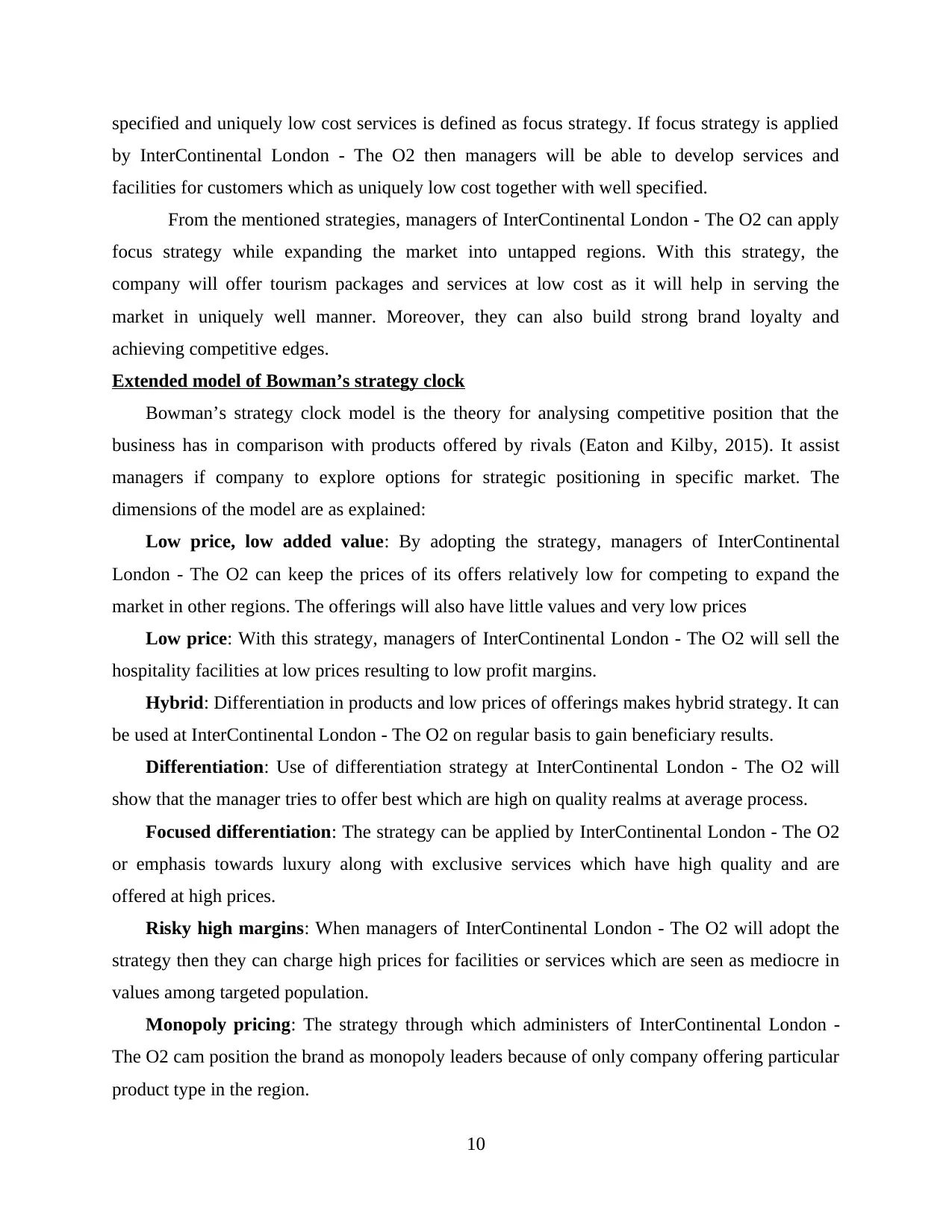
specified and uniquely low cost services is defined as focus strategy. If focus strategy is applied
by InterContinental London - The O2 then managers will be able to develop services and
facilities for customers which as uniquely low cost together with well specified.
From the mentioned strategies, managers of InterContinental London - The O2 can apply
focus strategy while expanding the market into untapped regions. With this strategy, the
company will offer tourism packages and services at low cost as it will help in serving the
market in uniquely well manner. Moreover, they can also build strong brand loyalty and
achieving competitive edges.
Extended model of Bowman’s strategy clock
Bowman’s strategy clock model is the theory for analysing competitive position that the
business has in comparison with products offered by rivals (Eaton and Kilby, 2015). It assist
managers if company to explore options for strategic positioning in specific market. The
dimensions of the model are as explained:
Low price, low added value: By adopting the strategy, managers of InterContinental
London - The O2 can keep the prices of its offers relatively low for competing to expand the
market in other regions. The offerings will also have little values and very low prices
Low price: With this strategy, managers of InterContinental London - The O2 will sell the
hospitality facilities at low prices resulting to low profit margins.
Hybrid: Differentiation in products and low prices of offerings makes hybrid strategy. It can
be used at InterContinental London - The O2 on regular basis to gain beneficiary results.
Differentiation: Use of differentiation strategy at InterContinental London - The O2 will
show that the manager tries to offer best which are high on quality realms at average process.
Focused differentiation: The strategy can be applied by InterContinental London - The O2
or emphasis towards luxury along with exclusive services which have high quality and are
offered at high prices.
Risky high margins: When managers of InterContinental London - The O2 will adopt the
strategy then they can charge high prices for facilities or services which are seen as mediocre in
values among targeted population.
Monopoly pricing: The strategy through which administers of InterContinental London -
The O2 cam position the brand as monopoly leaders because of only company offering particular
product type in the region.
10
by InterContinental London - The O2 then managers will be able to develop services and
facilities for customers which as uniquely low cost together with well specified.
From the mentioned strategies, managers of InterContinental London - The O2 can apply
focus strategy while expanding the market into untapped regions. With this strategy, the
company will offer tourism packages and services at low cost as it will help in serving the
market in uniquely well manner. Moreover, they can also build strong brand loyalty and
achieving competitive edges.
Extended model of Bowman’s strategy clock
Bowman’s strategy clock model is the theory for analysing competitive position that the
business has in comparison with products offered by rivals (Eaton and Kilby, 2015). It assist
managers if company to explore options for strategic positioning in specific market. The
dimensions of the model are as explained:
Low price, low added value: By adopting the strategy, managers of InterContinental
London - The O2 can keep the prices of its offers relatively low for competing to expand the
market in other regions. The offerings will also have little values and very low prices
Low price: With this strategy, managers of InterContinental London - The O2 will sell the
hospitality facilities at low prices resulting to low profit margins.
Hybrid: Differentiation in products and low prices of offerings makes hybrid strategy. It can
be used at InterContinental London - The O2 on regular basis to gain beneficiary results.
Differentiation: Use of differentiation strategy at InterContinental London - The O2 will
show that the manager tries to offer best which are high on quality realms at average process.
Focused differentiation: The strategy can be applied by InterContinental London - The O2
or emphasis towards luxury along with exclusive services which have high quality and are
offered at high prices.
Risky high margins: When managers of InterContinental London - The O2 will adopt the
strategy then they can charge high prices for facilities or services which are seen as mediocre in
values among targeted population.
Monopoly pricing: The strategy through which administers of InterContinental London -
The O2 cam position the brand as monopoly leaders because of only company offering particular
product type in the region.
10
⊘ This is a preview!⊘
Do you want full access?
Subscribe today to unlock all pages.

Trusted by 1+ million students worldwide
1 out of 15
Related Documents
Your All-in-One AI-Powered Toolkit for Academic Success.
+13062052269
info@desklib.com
Available 24*7 on WhatsApp / Email
![[object Object]](/_next/static/media/star-bottom.7253800d.svg)
Unlock your academic potential
Copyright © 2020–2025 A2Z Services. All Rights Reserved. Developed and managed by ZUCOL.




